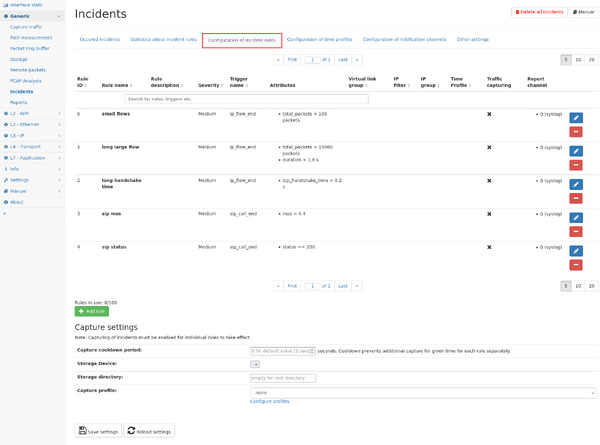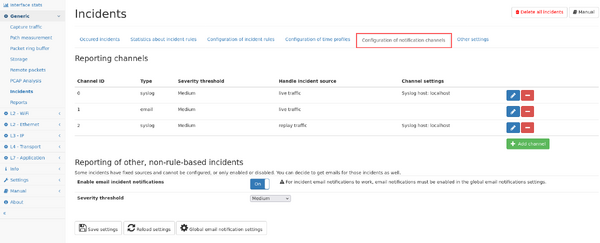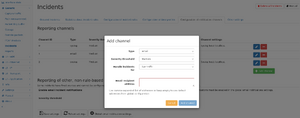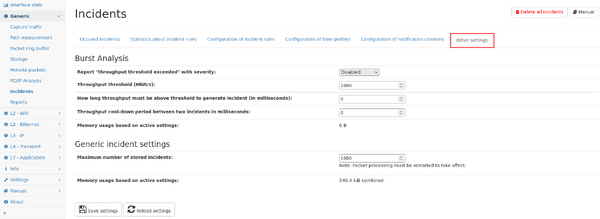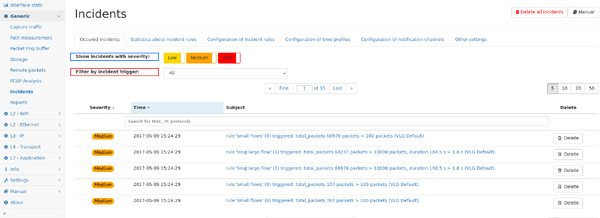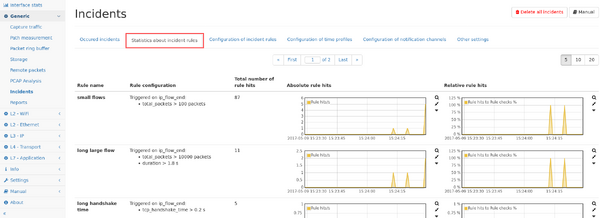Incidents: Difference between revisions
| Line 286: | Line 286: | ||
* lacp_channel_status_change | * lacp_channel_status_change | ||
** channel_status: 0 means that the LACP port channel is not synchronized, 1 means that the LACP port channel is synchronized. | ** channel_status: 0 means that the LACP port channel is not synchronized, 1 means that the LACP port channel is synchronized. | ||
=== Capture settings === | |||
Since firmware version 3.7, it is possible to automatically capture traffic for occurred incidents. These global settings control where capture files are stored and the capturing itself can be enabled for each rule separately. | |||
The incident capture feature requires an active packet ring buffer since the packets are extracted from the buffer at the end of the incident period. | |||
Available settings: | |||
* Capture cooldown period: For each rule a cooldown period stops multiple captures happen in fast succession. By default, new captures happens firstly after 5 seconds, but any other value of at least 1 second can be configured. The cooldown is applied to each rule separately, but for each individual rule it does not matter if the same or a different entity triggers an incident. The incident is still reported within the cooldown period, but no additional capture is started. | |||
* Storage device: Select the storage device where the captures should be stored on. | |||
* Storage directory: Enter the directory where capture files should be stored or leave empty to use the top level directory. | |||
* Select packet ring buffer to capture from: if multiple ring buffer cluster are in use, you can select which ring buffer to use for extraction. | |||
* Capture profile: A capture profile can be configured to apply packet truncation rules to the capture file. If unset, the complete packets are captured (if the ring buffer uses separate truncation rules, truncated packets might still be within the capture file). | |||
== Channel configuration == | == Channel configuration == | ||
Revision as of 14:22, 19 December 2022
Incidents are used to alarm the user when configured network events occur, usually for traffic based rules, but also for system-specific events. These notifications can be viewed in the web GUI and may also be delivered by email or syslog. Repeating incidents are counted as such and the time of the first and last occurrence of an incident is remembered. This feature can be disabled for some incidents. What makes an incident unique depends on the type of incident.
The incident feature allows to define rules which are checked on the configured trigger point, like when a connection ends, a SIP call ends, or for checks on ongoing traffic. When such a trigger hits, configurable traffic attributes will be checked and if all attributes of a rule matches, an incident is created.
Occurred incidents can be seen in the web interface, and additionally reporting via email or syslog is possible too.
The first occurrence of a medium or high severity incident will also trigger a status notification which is visible at the top right of the web GUI.
Up to 1000 incidents will be remembered by the system and if this limit is exceeded the oldest incidents will be discarded.
Rule configuration
Incident rules can be defined in the "Configuration of incident rules" tab in the menu "Generic -> Incidents". All changes to the rule configuration will only take affect after saving the current configuration by clicking on the save button at the bottom of the page.
The page shows a table containing the existing rules and their configuration.
Each existing rule can be modified by clicking on the pencil symbol, or deleted by clicking on the "minus" symbol.
New rules can be added by clicking on the "Add rule" button. A dialog appears allowing for configuration of the rule. The same dialog is used when modifying an existing rule.
Add/modify a rule
A rule is defined by the following settings:
- Rule text: This is an arbitrary text describing the purpose of the rule. This text is shown in the incident list and email/syslog ouptut.
- Severity: three different severity values "low", "medium", and "high" can be used to group more important and less important incidents. Reporting channels can be configured to only report incidents of a minimum severity level. A rule can also be disabled by choosing the severity level "disabled". It will not be evaluated and can be enabled later at will.
- Trigger: The trigger defines when a rule is evaluated. For each available trigger, a description is shown next to it giving more details about the trigger. Some triggers are evaluated at a very specific time, like when a VoIP call ends, or are evaluated regularly like for throughput triggers of IP traffic which can be configured to be checked once very minute or hour or so. See list below for a detailed description of the available triggers.
- Attributes: Attributes are used to make actual comparison of expected values vs. actual values.
- Each trigger has a different set of attributes which can be checked for, and some triggers don't need to have an attribute at all. See list below for a detailed description of the available attributes
- Up to four attributes can be added by clicking on the "Add attribute" button.
- Multiple attributes must all match at the same time to let the rule create an incident.
- Each attribute can be compared to a specific value, so that the actual value is lower, equal, or greater than a defined value.
- Some attributes have an additional parameter, like a timespan which defines how the attribute value is calculated.
- Virtual link group: The rule can be limited to a selected virtual link group or to be applied for any group. Some triggers cannot be limited to a virtual link group so the configuration will be hidden.
- IP filter: Depending on the selected trigger, the rule can be limited to a specific IP address. In firmware version >= 3.7, the IP filter can also be an IP subnet in the format IP/masklen (Example: 10.0.0.0/8)
- IP group: Depending on the selected trigger, the rule can be apply to IP group instead of individual IP address.
- Virtual link group, IP and IP filter can also be used inversely by using the != comparator
- Report channel: Incidents are always visible in the web interface, but can also be reported via multiple channels which can be configured separately in the tab "Configuration of notification channels". Up to ten channels can be selected so that the incident for this rule is reported on each channel. Also, no channel can be configured so the incident is only accessible on the web interface.
- Aggregation: Incidents are aggregated by default. This means the table only shows the number of incidents of the type and the timestamps of the first and the last incident. This can be disabled for most of the incidents, so that you are able to see every indent of the incident-type.
- Traffic capturing [since version >= 3.7]: If supported by the trigger, the rule can be configured to capture the network traffic triggering the rule, including some extra time before and after the incident.
- Possible options:
- Disabled: capturing is disabled for this rule
- Live traffic: capturing happens only for live network traffic
- Replay traffic: capturing happens only for replayed network traffic (from PCAP files)
- Always: capturing happens in all traffic processing types.
- Extra capture time: configure the number of seconds before the start of the incident and after the end of the incident.
- If a timespan parameter is used for attributes, the capture time includes this time duration as well.
- The traffic is automatically filtered to only contain the traffic that actually triggered the rule, i.e., an IP address or an IP group for IP rules.
- Possible options:
Available triggers
| Trigger name | Description | Attribute usage |
|---|---|---|
| mac_traffic | This trigger is checked continuously for each active MAC address. The update interval is defined by the timespan parameter of the attributes. | mandatory |
| mac_new_address | This trigger is checked once when a new unicast MAC address appears for the first time. | optional |
| mac_new_l7_protocol | This trigger is checked when a unicast MAC address uses a l7 protocol for the first time. | optional |
| arp_ip_mac_changed | This trigger is checked on an ARP response and MAC address changed for a requested IP. | optional |
| ip_flow_end | This trigger checks the attributes whenever an IP flow ended. | mandatory |
| ip_flow_start | This trigger checks the attributes whenever an IP flow starts. | mandatory |
| ip_traffic | This trigger is checked continuously for each active IP or IP group. The update interval is defined by the timespan parameter of the attributes. | mandatory |
| ip_new_local_ip | This trigger is checked once for each new IP belonging to a private network address range. | optional |
| ip_new_local_l7_protocol | This trigger is checked once for each new l7 protocol used by a local IP. | optional |
| ip_local_ip_multiple_macs | This trigger is checked on each new flow of a local IP address and more than one MAC address uses this IP. | optional |
| ip_tcp_handshake | This trigger is checked after successful TCP handshake. | mandatory |
| qos_traffic | This trigger is checked continuously for each active QoS class. The update interval is defined by the timespan parameter of the attributes. | mandatory |
| dns_server_not_responding | This trigger is checked when a DNS server is not responding for some time. A server is considered unresponsive when more than 3 requests to the DNS server went unanswered for a period of more than 5 seconds. Such a server must have answered at least two requests previously. | optional |
| dns_server_response_error | This trigger is checked when a DNS server responds a configured error of type format error, server failure or non-existing domain | mandatory |
| sip_call_end | This trigger is checked when a SIP call ended. | mandatory |
| global_interface_status_change | This trigger is checked when the status of an interfaces changes. | optional |
| global_interface_speed_change | This trigger is checked when the speed of an interfaces changes. | optional |
| global_interface_speed_mismatch | This trigger is checked when the status or speed of an interfaces changes and mismatches the speed of corresponding interface of a link. | optional |
| global_gps_sync_status_change | This trigger is checked when the GPS clock synchronization status changes. | optional |
| global_traffic | This trigger is checked continuously for the total traffic of the device. The update interval is defined by the timespan parameter of the attributes. | mandatory |
| global_regex_match | This trigger allows to configure a list of regular expressions and is checked for each packet whose L7 data matches one of the regular expressions in the list. Since there are no attributes associated with this trigger, this effectively means that any packet which matches one of the regular expressions will result in an incident. The incident also contains information about which connection this packet belongs to as well as which of the regular expressions matches the packet. | no attributes are available for this trigger |
| rtp_traffic | This trigger is checked continuously for traffic of each RTP connection. The update interval is defined by the timespan parameter of the attributes. | mandatory |
| ptp_timestamp_packet | This trigger is checked when a PTP packet containing a valid timestamp is seen. | mandatory |
| smb_v1_negotiation | This trigger is executed at the beginning of each SMB connection and checks whether insecure SMB1 has been negotiated. | none |
| global_connections | This trigger is checked continuously whether the amount of newly created connections exceeds a threshold. The update interval is defined by the timespan parameter of the attributes. | mandatory |
| global_new_connection | This trigger is checked continuously at connection start. It can be used to report new connections with a certain layer 4 protocol and a given port range. | mandatory |
| ssl_handshake | This trigger is checked during handshake of each SSL connection. | mandatory |
| pppoe_discovery_traffic | This trigger is checked continuously for PPPoE discovery traffic. The update interval is defined by the timespan parameter of the attributes. | mandatory |
| lacp_channel_status_change | This trigger is checked when the status of a LACP port channel changes. | optional |
Special trigger properties
Some trigger are checked continuously every configured time span period, so the incidents are generated differently than for fixed event specific triggers like a call end.
- Repeating incidents: The following triggers will be evaluated every configured time span and will be re-issued whenever the configured attributes match.
- mac_traffic
- ip_traffic
- qos_traffic
- rtp_traffic
- Start/stop incidents: The following triggers are reported once the configured attributes match and for a second time when the attributes no longer match.
- global_traffic
So for repeating incidents you will get repeated incidents for the same attribute every time span. For example, if an IP address has traffic of 100 mbit/s for 2 minutes and a rule checks for more than 50 mbit/s over 30 seconds, the rule will hit 4 times. There will be one incident which will contain the exact number of repetitions for reference.
For start/stop incidents, you will only see two rule hits and the incident description will state the start and stop time.
Available attributes
- mac_traffic
- broadcast_packet_rate: The attribute is the number of packets per second on average over the configured timespan for MAC broadcast packets.
- mac_new_address
- since_start_time: This is number of seconds after packet processing start when the MAC address appeared. This is useful to only report new MAC address after some learning time.
- mac_new_l7_protocol
- since_start_time: This is number of seconds after packet processing start when the MAC address appeared. This is useful to only report new MAC address after some learning time.
- arp_ip_mac_changed
- time_since_last_mac: This is number of seconds between changed MAC addresses. If, for examples, dynamic IP assignment is used, changing MAC addresses is normal so the test can be limited to only a certain amount of time.
- ip_flow_end
- total_packets: The total number of packets seen for both directions of the flow.
- total_bytes: The total number of bytes seen for both directions of the flow.
- tcp_handshake_time: The TCP handshake time.
- percent_transmissions: The amount of TCP retransmission as a percentage of the total bytes.
- zero_window_packets: The number of packets with a TCP window of 0 for both directions of the flow.
- duration: The time between first and last packet of the flow.
- ip_flow_start
- new_connections: The amount of newly created connections (TCP and UDP) for the given timespan.
- ip_traffic
- throughput: The throughput bandwidth in bit/s on average during the configured timespan.
- throughput_increase: The throughput bandwidth increase in % during the configured timespan compared to the average throughput of the given baseline timespan. The noise can be configured to allow deviations that should not lead to trigger the incident.
- packet_rate: The packet rate in pps on average during the configured timespan.
- packet_rate_increase: The packet rate increase in % during the configured timespan compared to the average packet rate of the given baseline timespan. The noise can be configured to allow deviations that should not lead to trigger the incident.
- total_packets: The number of packets seen in the configured timespan.
- total_bytes: The number of bytes seen in the configured timespan.
- retransmission_ratio: The TCP retransmission ratio seen in the configured timespan.
- zero_window_packets: The number of zero window packets seen in the configured timespan.
- tcp_syn_packets: The number of TCP SYN packets (RX + TX) seen in the configured timespan.
- tcp_fin_packets: The number of TCP FIN packets (RX + TX) seen in the configured timespan.
- tcp_rst_packets: The number of TCP RST packets (RX + TX) seen in the configured timespan.
- ip_new_local_ip
- since_start_time: This is number of seconds after packet processing start when the MAC address appeared. This is useful to only report new MAC address after some learning time.
- ip_new_local_l7_protocol
- since_start_time: This is number of seconds after packet processing start when the MAC address appeared. This is useful to only report new MAC address after some learning time.
- ip_local_ip_multiple_macs
- mac_count: The number of different MAC address for the corresponding IP address.
- ip_tcp_handshake
- handshake_time: The TCP handshake time between the first SYN packet and the ACK packet for the SYN/ACK packet of the server.
- server_handshake_time: The TCP handshake time between the first SYN packet of the client and the SYN/ACK packet of the server.
- client_handshake_time: The TCP handshake time between the SYN/ACK packet of the server and the ACK packet of the client.
- qos_traffic
- throughput: The throughput bandwidth in bit/s on average during the configured timespan.
- total_packets: The number of packets seen in the configured timespan.
- total_bytes: The number of bytes seen in the configured timespan.
- dns_server_not_responding
- time_since_first_unanswered_request: This is the time span between when the trigger is checked and the first DNS request that has not been answered by the DNS server.
- dns_server_response_error
- error_type: equal or not equal to:
- Format Error: DNS responds a format error.
- Non-existent Domain: DNS could not find queried domain name.
- Server Failure: DNS responds server failure.
- error_type: equal or not equal to:
- sip_call_end
- duration: The call duration.
- status: The call status code (a three digit number, like 200 for Success)
- mos: The average MOS quality value of the call, using the minimum of both call sides.
- percent_loss: The percentage of RTP packet loss for the call, accounting packets from both directions.
- jitter: The average jitter of the call, using the maximum value of both call sides.
- total_packets: The number of packets seen in the configured timespan.
- total_caller_packets: The number of packets seen for the caller of the call.
- total_callee_packets: The number of packets seen for the callee of the call.
- total_bytes: The number of bytes seen in the configured timespan.
- total_caller_bytes: The number of bytes seen for the caller of the call.
- total_callee_bytes: The number of bytes seen for the callee of the call.
- global_interface_status_change
- interface_status: 0 means interface is down, 1 means interface is up.
- global_interface_speed_change
- interface_speed: The current speed of the interface in mbit/s.
- global_interface_speed_mismatch
- link_speed_difference: This is the absolute difference between the speeds of both interface of a link in mbit/s.
- global_gps_sync_status_change
- gps_sync_status: 0 means that the GPS clock in not synchronized, 1 means that the GPS clock is synchronized.
- global_traffic
- throughput: The throughput bandwidth in bit/s on average during the configured timespan.
- throughput_increase: The throughput bandwidth increase in % during the configured timespan compared to the average throughput of the given baseline timespan. The noise can be configured to allow deviations that should not lead to trigger the incident.
- packet_rate: The packet packets/s on average during the configured timespan.
- packet_rate_increase: The packet rate increase in % during the configured timespan compared to the average packet rate of the given baseline timespan. The noise can be configured to allow deviations that should not lead to trigger the incident.
- rtp_traffic
- jitter: The average jitter of the RTP connection for the given timespan, using the maximum value of both directions.
- percent_loss: The percentage of RTP packet loss for the given timespan, accounting packets from both directions of the RTP connection.
- ptp_timestamp_packet
- time_offset: The time offset between the local time and the timestamp seen in the PTP packet.
- global_connections
- new_connections: The amount of newly created connections (TCP and UDP) for the given timespan.
- global_new_connection:
- l4_protocol: The layer 4 protocol. Can be TCP, UDP or other.
- port_range: The TCP or UDP port. Can be also a range, e.g. 80,443,8443-8445
- since_start time: This is number of seconds after packet processing start when the connection hast been started. This is useful to only report new connections after some learning time.
- ssl_handshake:
- certificate_expires: This is the number of days until the certificate expires. If the certificate is already expired, the value is <= 0.
- tls_version:
- used_tls_version: The TLS version (SSl 3.0, TLS 1.0, TLS 1.1, TLS 1.2 or TLS 1.3)
- pppoe_discovery_traffic
- pppoe_discovery_packets: The number of PPPoE discovery packets seen during the configured timespan.
- type: The type of PPPoE discovery packet (PADI, PADO, PADR, PADS, PADT or any).
- lacp_channel_status_change
- channel_status: 0 means that the LACP port channel is not synchronized, 1 means that the LACP port channel is synchronized.
Capture settings
Since firmware version 3.7, it is possible to automatically capture traffic for occurred incidents. These global settings control where capture files are stored and the capturing itself can be enabled for each rule separately.
The incident capture feature requires an active packet ring buffer since the packets are extracted from the buffer at the end of the incident period.
Available settings:
- Capture cooldown period: For each rule a cooldown period stops multiple captures happen in fast succession. By default, new captures happens firstly after 5 seconds, but any other value of at least 1 second can be configured. The cooldown is applied to each rule separately, but for each individual rule it does not matter if the same or a different entity triggers an incident. The incident is still reported within the cooldown period, but no additional capture is started.
- Storage device: Select the storage device where the captures should be stored on.
- Storage directory: Enter the directory where capture files should be stored or leave empty to use the top level directory.
- Select packet ring buffer to capture from: if multiple ring buffer cluster are in use, you can select which ring buffer to use for extraction.
- Capture profile: A capture profile can be configured to apply packet truncation rules to the capture file. If unset, the complete packets are captured (if the ring buffer uses separate truncation rules, truncated packets might still be within the capture file).
Channel configuration
Incidents can be reported on different channels. The configuration allows to add new channels so they can be selected in the rule configuration described above.
Each channel can be of type:
- email: Incidents will be sent to the email address configured in the Global settings.
- syslog: Incidents will be sent to the configured syslog server via TCP on port 514. Firmware >= 3.3: Configuration allows for TCP or UDP on any port.
Each channel also uses a minimum severity settings so only incidents are reported which are of at least that severity.
Each channel can be configured to only handle incidents from live traffic or from replayed traffic.
Some incidents cannot be configured via rules and you can choose to get those incidents also via email by enabling the settings at the lower part of the settings page.
Burst incident settings
Burst incidents with milli-second resolution can be generated when the interface throughput exceeds a configurable threshold. The incident contains a graph of traffic for that interface with some data points before and after the threshold has been exceeded depending on the measurement interval. A PCAP link for capturing from the packet ring buffer is shown. For further investigation of that incident, the button Use as global time range can be used to set the global range to the start and end of the incident graph (at least 5 seconds) so that all modules of the Allegro Network Multimeter show that time span. The incident generation can be configured as follows:
- throughput threshold exceeded: report an incident if the throughput of any network interface exceeded.
- Throughput threshold (Mbit/s): The threshold is configured in Mbit/s.
- How long throughput must be above threshold to generate incident (in milliseconds): The throughput must exceed the threshold for this duration in order to generate the incident. If set to zero (default) the incident is generated immediately after the threshold has been exceeded.
- Throughput cool-down period between two incidents in milliseconds: Defines the time after an incident where no new incident is generated even if the threshold is exceeded. If this period is passed, throughput incidents could be generated again.
Occured incident view
This page shows up to the last 1000 incidents occurred on the system. The table can be filtered for specific severity levels, as well as for specific trigger sources by selecting the trigger from the drop down menu.
The list can also be filtered for the subject of the incident.
Individual incidents can be view in detail by clicking on the subject. The details page shows detailed information including links to the relevant measurement page.
Incidents can be deleted individually by clicking on the delete button next to the incident, or all incident can be deleted by clicking on the button on the top right of the page.
Rule statistics
This page shows graphs about how often each rule has been hit both in absolute numbers as well as relatively to how often the rule has been checked.
Incident list per measurement modules
Since incidents are triggered by different measurement modules (as indicate by the prefix of the trigger name, like the mac or ip module), the list of incidents from that specific module can also be seen in the corresponding tab of the measurement module for quicker access. This per-module view only lists those incidents coming from that module, all other potential incidents are hidden and must be accessed in their corresponding module page, or in the global view in the "Generic -> Incident" menu.
Limitations
Some technical limitations apply:
- continuously checked triggers like "IP traffic" are only evaluated if there was at least one packet in the corresponding time interval. Therefore, rules check for zero packet count or throughput will never match.ys

